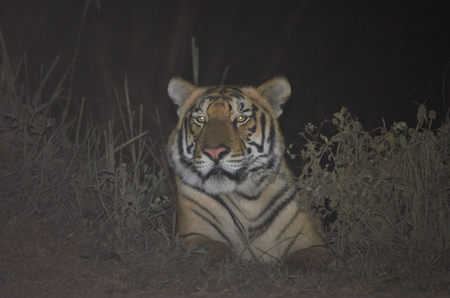
Guwahati, July 29 (IANS) Kaziranga National Park and Tiger Reserve (KNPTR), home to Greater one-horned Rhinoceroses, now ranks third in the world for highest tiger density, with 18 tigers per 100 sq km, officials said on Tuesday.
KNPTR Director Sonali Ghosh said that as per the latest report “Status of Tigers in Kaziranga, 2024”, a total of 148 adult tigers were identified in Kaziranga Tiger Reserve’s (KTR) three divisions against 104 in 2022.
Of the total of 148 tigers, 83 are females, 55 are males, and 10 with undetermined gender.
“This growth is particularly notable due to the first-time sampling of the Biswanath Wildlife Division, where 27 recorded tigers have contributed to the overall increase. In the core Eastern Assam Wildlife Division, the population grew from 104 in 2022 to 115 in 2024, while the Nagaon Wildlife Division maintained a stable count of 6 tigers,” the KNPTR Director said.
She said that methodology for the tiger count included the deployment of remotely triggered camera traps as per the Phase IV Protocol of the National Tiger Conservation Authority (NTCA) and the Wildlife Institute of India.
According to the senior Indian Forest Service (IFS) official, paired camera traps were systematically placed across 1,307.49 sq km within three divisions of Kaziranga Tiger Reserve between December 2023 and April 2024, using a structured grid-based design to ensure comprehensive spatial coverage.
Trap sites within each grid cell were selected based on intensive sign surveys to maximize the probability of detecting tigers and co-predators.
Assam Chief Minister Himanta Biswa Sarma, while declaring the results of the tiger census, said in the social media posts: “From Kaziranga to Manas, Assam is not only limited to protecting the tiger, but it is also playing an important role in restoring the tiger’s habitat. With the third-highest tiger density in the world, extensive forest cover, and bold steps against infiltration, the tiger, the treasure of Assam’s forests, is walking proudly and bravely today.”
KNPTR Director Ghosh said that the main drivers of this encouraging rise in tiger population are habitat expansion and protection.
An additional area of 200 sq km, including 12.82 sq km of encroachment-free area, has been added in recent years under Burhachapori-Laokhowa sanctuaries in Nagaon Wildlife Division, bringing more habitats under the protection of the Tiger Reserve.
This strategic extension has significantly expanded the landscape available to tigers, allowing for increased movement, breeding, and dispersal opportunities across divisions, the official pointed out.
In addition, the enhanced use of technology has revolutionized wildlife monitoring and protection, she claimed, and said that, along with camera traps, drones, and infrared-based electronic surveillance systems (“Electronic Eye”), are now integral to daily operations.
According to the KNPTR Director, technological advancements have greatly improved anti-poaching measures, movement tracking, and habitat monitoring, leading to greater safety and better data.
Crucially, the integration of advanced technologies with meticulous efforts of the forest frontline staff, including 113 trained ‘Van Durgas’, the female frontline staff of the Tiger Reserve, and the active support of civil society organisations and local communities has significantly helped fill historical data gaps, she noted.
In recent years, Kaziranga’s tiger monitoring has produced gender-wise segregation data, offering a more accurate and detailed understanding of the reserve’s tiger demography.
Noting that the rise in the tiger population is more than just a statistic, Ghosh said that it signifies the health and resilience of the entire ecosystem within Kaziranga, which supports a diverse range of flora and fauna.
The thriving tiger population is a testament to our successful conservation efforts.
“While we celebrate this milestone, we also recognise the responsibility it brings. It is crucial to continue investing in conservation initiatives, strengthen community involvement, and promote awareness about the importance of biodiversity,” the IFS official said.
–IANS
sc/skp



